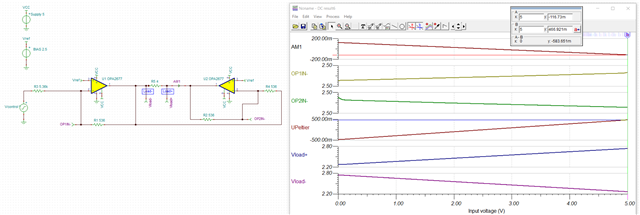Other Parts Discussed in Thread: OPA567, OPA569, OPA2675
Hello,
I need to drive a small thermoelectric device (peltier) in order to control the temperature of a laser diode. The peltier operating range is +/- 100 mA with a compliance voltage of about +/- 400 mV.
The voltage for controlling the peltier current is provided by a DAC which has a max. output voltage of 5 V and a reset voltage of 2.5 V ("mid scale"). Further I'd like to use a single supply rail of 5 V.
I came up with a simple bridge setup consisting of two complementary inverting opamps. For the simulation, the peltier was represented by a 4 Ohm resistive load:

I calculated Vload = Vload+ - Vload- = 2 * (Vcontrol - Vbias ) * G with Gain G = R1 / R2 and Vbias = 2,5 V.
To achieve a Vload = 0,5 V at a maximum DAC output of Vcontrol = 5 V, I calculated a gain of G = 0.1
However, the simulation shows that a gain G = 0.2 is better in order to get the required output swing:

The graphs show that the negative inputs of both op amps are close the the bias voltage at the positive inputs. This means the op amps are operating in their linear regime. The voltage at the peltier Vload ("UPeltier" in the graph) and the peltier current ("AM1" in the graph) cover the required range. It seems the design should meet the requirements described above.
Now my questions:
1. Why is my calculation off by about a factor of 2?
2. Could this work in reality (e.g., power dissipation, startup behavior) and have you comments regarding the design (e.g. op amp configuration, improvements to be made)?
3. I could only find three devices which would work in this design. I chose the OPA2677 as the other two (OPA567 and OPA569) are too "big" in my opinion. Can you suggest alternative devices for the OPA2677?
In case you want to run the simulation, this is the simulation file:
BridgeComplementaryInvertedOPA2677-G=0.2.TSC
Thanks a lot.
Dan


